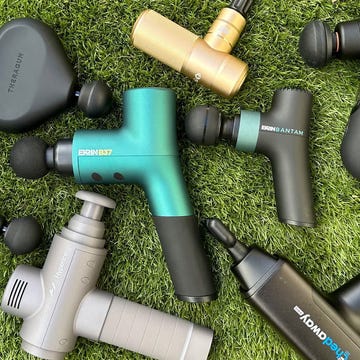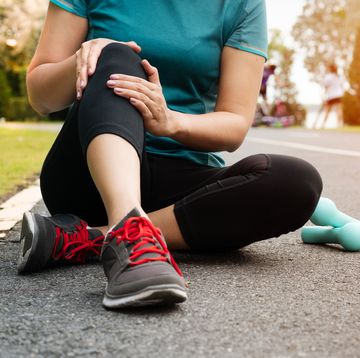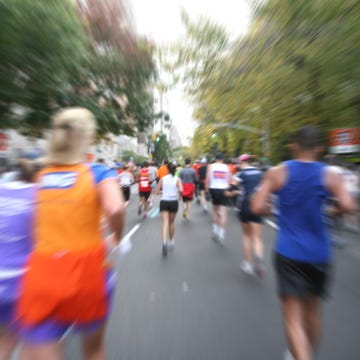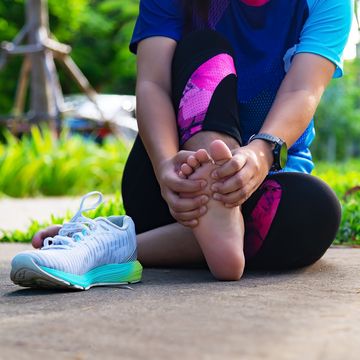You peel off your running sock and – alas! – there it is: your first bruised toenail.
Many runners view bruised toenails as a rite of passage, but you are no less of a runner if you never get one. In fact, not getting a bruised toenail is arguably a greater running flex – so what causes this common ailment and how can you avoid it? And if you’re already adorned with a bruised toenail or two, what can you do to assist the healing process? We consulted the experts to discover exactly how to prevent and soothe bruised toenails.
What exactly is a bruised toenail?
The official medical term for a bruised toenail is subungual haematoma, which is a complicated way of saying ‘blood under the nail’.
What everyone's reading
Essentially, bruised toenails occur when the blood vessels under the nail are broken and blood – which has nowhere else to go – pools in the area, giving the nail its blackened appearance. Although bruised toenails can affect anyone, they can be regular problems for runners who train frequently or run long distances.
What causes a bruised toenail?
Simone Paul, senior podiatrist and CEO of The Footlift Clinic in London, says that a combination of repetitive friction, impact, pressure and swelling of the toes can bring about a bruised toenail. ‘The feet swell significantly during running and this creates less space in the shoe,’ she explains. ‘As a result, the toes continuously hit the roof of the footwear and rub against each other, which puts the capillaries under pressure.’
Bruising of the nail bed and plate – and the dark discolouration caused by the collected blood underneath the nail – can occur quickly. According to Paul, runners with congenital and acquired lesser toe deformities such as claw, hammer toe or hallux valgus (bunions) are at a greater risk of developing bruised toenails.
Christophe Champs, a biomechanics expert and the founder of the PODO Clinic and Workshop, points to a few other factors that can cause bruised toenails. Wearing running socks that are too small or too tight can increase the risk of toenail bruising, as can the impact of your toes hitting the front of your running shoes, which worsens when running downhill.
On the subject of running shoes, wearing pairs that are either too small or too big can present their own unique problems. It will come as no surprise that running in shoes that are too small will lead to a very unhappy situation, since cramped feet suffer additional pressure and repeated friction on the skin and nails. On the other hand, if your running shoes are too big or the toe box is too wide, the twisting motion of the foot forces your bodyweight forward and the toes grasp to gain more stability, with the lesser toes curling up. When the tips of the toes are in ‘conflict with the footwear’, says Champs, bruised toenails and blisters can form.
How can you heal a bruised toenail quickly?
Although it might be tempting, avoid trying invasive treatments on a bruised toenail at home. DIY toenail care can easily lead to infection, so Champs says that it’s best to play it safe. ‘Respect the highest standards of hygiene when clearing and cleaning skin or nail damage, whether it’s bleeding or infected or not,’ he stresses. If you have any concerns regarding the skin and nail damage, he adds, consult a healthcare professional.
Keeping the nail clean and dry is crucial. Paul advises drying any bruised toenails after a bath or shower by pressing lightly on the area with a towel. Then, use a tissue to reduce moisture in the bruise and to prevent fungal infections. Moisture present in the nail bed will increase the chance of the nail thickening (onychauxis), she says.
Paul also advises that you protect any bruised toenails with a sterile dressing while walking, as this will reduce tenderness and further bruising to the nail plate.
How long do bruised toenails last?
The healing time of a bruised toenail varies depending on several factors, such as how quickly your nails grow and the severity of the damage, explains Champs. If a bruised toenail falls off, it’s important to keep the area covered during physical activity, but to allow the area to breathe at night in a very clean environment. ‘Patience is key – just keep the area dry and clean at all times,’ he advises.
On average, though, you’re looking at a healing period lasting weeks to months, says Paul. For the big toe, which contains more capillaries, the bruising of the toenail may last six to eight months – and, in some cases, it can take over a year to grow out. For the other toes, it can take up to three months for bruised toenails to heal.
Should adapt your running if you have a bruised toenail?
If you’re set on running with a bruised toenail, Paul and Champs recommend changing up a few things first...
- Wear running shoes that are half a size bigger.
- Wear running socks that aren’t too tight, have no seams over the bruised area and can be pulled forward after you put them on.
- Cover the bruised toenail with a plaster.
- Try running on softer terrain, such as grass, to reduce the impact on your feet – and avoid running downhill.
- Since your feet swell slightly when you run, which could aggravate the injury, aim to do shorter runs during the healing period.
If your bruised toenail becomes painful, it’s best to stop running and seek advice from a healthcare professional.
How can runners prevent bruised toenails?
To begin, keep your toenails short and square to prevent them from catching on socks or conflicting with your shoes. Smoothen the corners with a glass file to avoid any ingrown toenails, too.
Paul also recommends wearing deeper and wider running shoes, plus split-toe compression socks to prevent swelling and friction to the nail plates.
What’s more, Champs suggests employing the runner’s loop lacing method, which helps to secure the foot more effectively and minimises movement inside the shoe. ‘This method is a game changer if you tend to run downhill,’ he says. ‘It holds the foot from sliding forward in the shoes and prevents the toes from hitting the firm and protective tip of the shoe.
‘Before using the top eyelets of the footwear to secure the heel, you can also re-lace your shoes completely by taking one lace from the top medial eyelet (the medial side of your ankle) to the last lateral eyelet (near your fifth toe),’ he adds. ‘Then, cross horizontally toward the first toe and cross this lace only, all the way up. Because you started from the second eyelet at the top, you will still be able to do the runner’s loop. It’s a great combo to avoid any excessive traction on the big toenail when tightening your shoelaces.’
Rachel is Runner's World UK's Senior Content Writer, covering all running-related topics from training advice and gear reviews to race reports and elite runner profiles. Formerly a Website Content Editor and Content Manager at London Marathon Events and The Running Channel respectively, Rachel is well-versed in the running scene and understands what it takes to put on some of the biggest running events in the world. A 2:50 marathoner, she would much rather run 26.2 miles than race a 5K and has currently completed 11 marathons, including five of the six Abbott World Marathon Majors in a sub-3 time. She now hopes to run the Tokyo Marathon to complete the set and become a Six Star Finisher.













